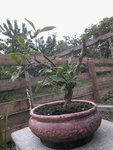About a month ago I was looking for information on euonymus/spindle tree/burning bush. I found that most of the members who wrote about it claimed that this species grows a single flush per year. However, there are people who claimed otherwise. So I tried it on this poor bastard.
I literally pulled it out of the ground in my garden in april 19th because I wanted to see if I can make something out of this species (not this tree). Barerooted and a little root pruned, I planted it in about 2-6 mm fired expanded clay and perlite. I added some chopped sphagnum moss on the surface for water retention and to keep the substrate in the pot when I water. I placed it in full sun and started feeding it after a day or so with lots of slow release lawn fertilizer (NPK 8-6-7), every 10 days. On may 31st, I decided to go ahead and prune the branches to see if they grow a second flush, as I had nothing to lose but an awfull specimen of a species that my garden has a lot. I was really happy to see the new growth after a week or so.
I decided to start this thread hoping that more of the members here who worked with spindle trees would share their experience so that others could find information easier on how to care for this species. I would really have loved a thread like this when I looked it up. I know there are some who enjoyed multiple flushes on it. I'm sure that there are a lot of things that matter, like substrate, fertiliser, climate, sun exposure, wattering and others that I can't think of right now.
Don't pay attention to the tree, it is really crappy, and it will probably be in Sorce's burn pile so I could graduate eventually, after I finish my experiments on it.
I literally pulled it out of the ground in my garden in april 19th because I wanted to see if I can make something out of this species (not this tree). Barerooted and a little root pruned, I planted it in about 2-6 mm fired expanded clay and perlite. I added some chopped sphagnum moss on the surface for water retention and to keep the substrate in the pot when I water. I placed it in full sun and started feeding it after a day or so with lots of slow release lawn fertilizer (NPK 8-6-7), every 10 days. On may 31st, I decided to go ahead and prune the branches to see if they grow a second flush, as I had nothing to lose but an awfull specimen of a species that my garden has a lot. I was really happy to see the new growth after a week or so.
I decided to start this thread hoping that more of the members here who worked with spindle trees would share their experience so that others could find information easier on how to care for this species. I would really have loved a thread like this when I looked it up. I know there are some who enjoyed multiple flushes on it. I'm sure that there are a lot of things that matter, like substrate, fertiliser, climate, sun exposure, wattering and others that I can't think of right now.
Don't pay attention to the tree, it is really crappy, and it will probably be in Sorce's burn pile so I could graduate eventually, after I finish my experiments on it.











